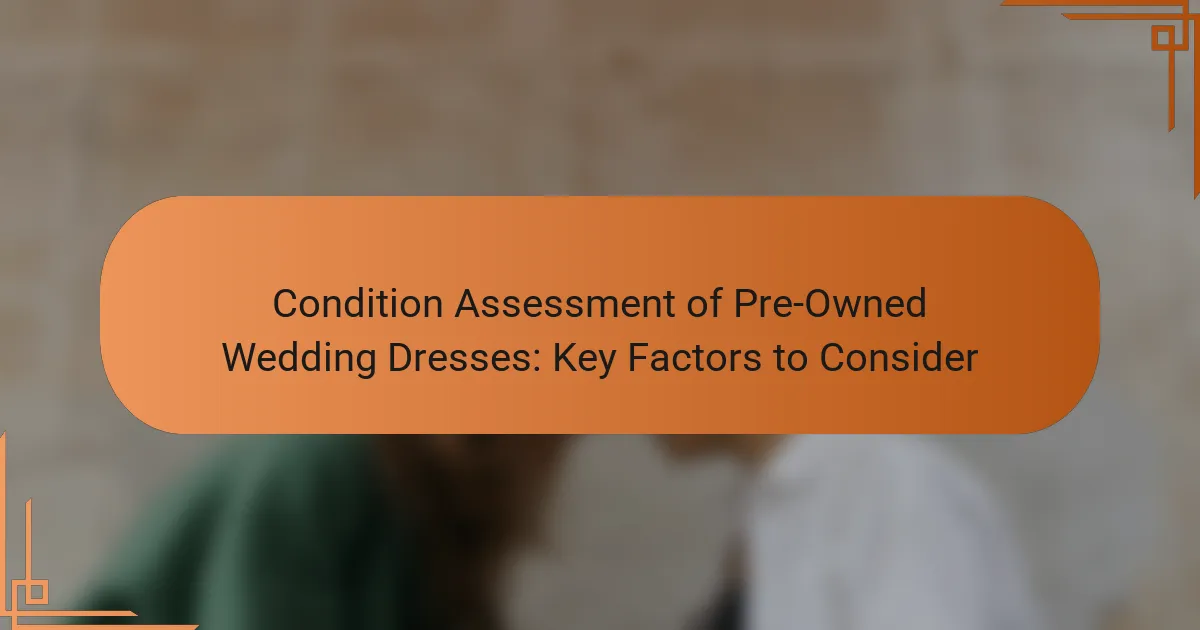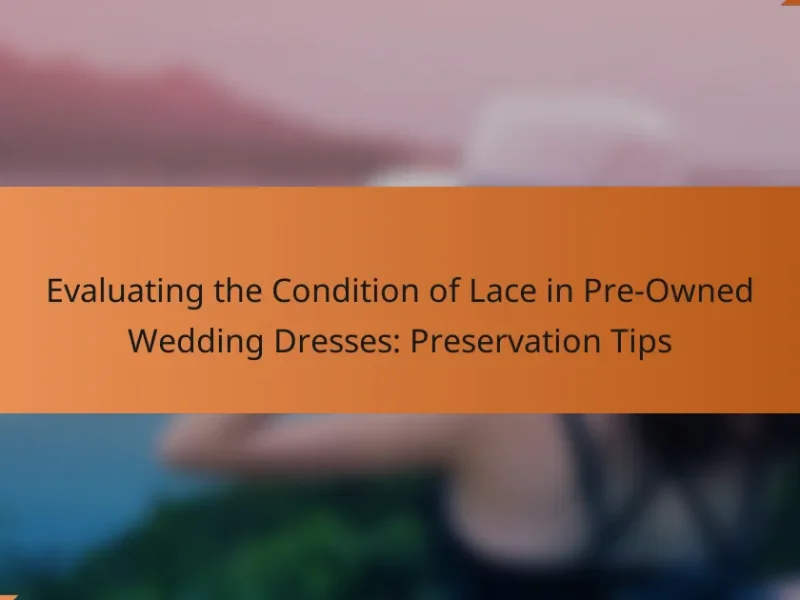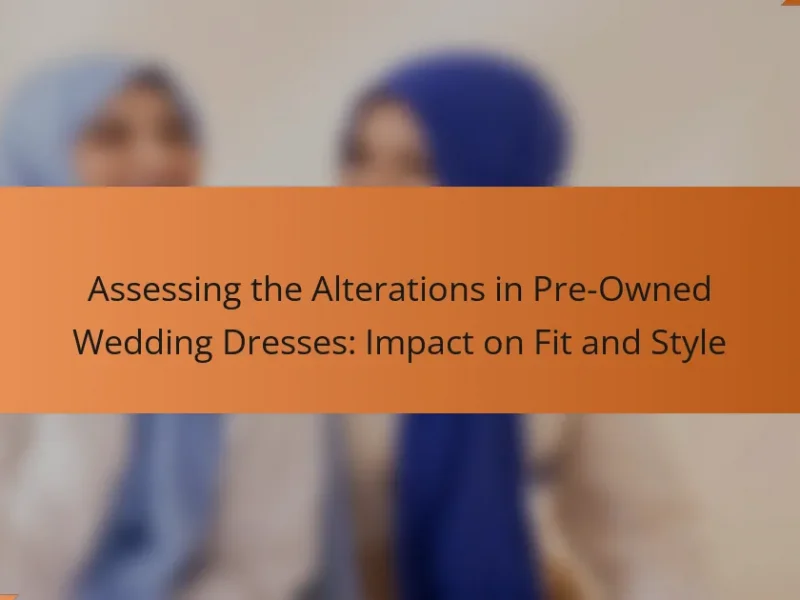The condition assessment of pre-owned wedding dresses evaluates their physical state, focusing on aspects such as fabric integrity, color fading, and structural damage. Key factors include inspecting for stains, tears, discoloration, and the condition of seams and closures, as well as the presence of original tags that indicate authenticity. This assessment is crucial for determining the dress’s resale value and its suitability for future use. Additionally, cleanliness, alterations, and embellishments are important considerations in evaluating the overall quality and potential for restoration of the dress.

What is the Condition Assessment of Pre-Owned Wedding Dresses?
The condition assessment of pre-owned wedding dresses evaluates their physical state and wear. This assessment includes inspecting for stains, tears, and discoloration. It also involves checking the integrity of seams and closures. A thorough examination of fabric quality is essential. Additionally, the presence of original tags or labels can indicate authenticity. The overall cleanliness of the dress is another important factor. These assessments help determine the dress’s resale value and suitability for future use.
Why is condition assessment important for pre-owned wedding dresses?
Condition assessment is important for pre-owned wedding dresses to ensure quality and value. It helps identify any damage, stains, or alterations that may affect the dress’s appearance and integrity. Assessing condition also informs potential buyers about the garment’s wear and tear history. Accurate assessments can enhance resale value by providing transparency. Proper evaluation can also guide necessary repairs or cleaning to restore the dress. Additionally, condition assessments can help buyers make informed decisions based on their budget and preferences. This process ultimately supports sustainable fashion practices by promoting the reuse of garments.
What factors contribute to the overall condition of a wedding dress?
The overall condition of a wedding dress is influenced by several factors. Fabric type affects durability and wear. Common materials include silk, satin, and lace, each with different care requirements. Storage conditions play a crucial role in preservation. Dresses stored in a cool, dry place are less likely to develop mold or mildew. Exposure to sunlight can cause fading and discoloration. Cleaning methods impact fabric integrity. Improper cleaning can lead to damage or staining. Age of the dress also matters; older dresses may show signs of wear and tear. Lastly, alterations and repairs can affect structural integrity and appearance. These factors collectively determine the overall condition of a wedding dress.
How does the condition of a wedding dress affect its resale value?
The condition of a wedding dress significantly impacts its resale value. A dress in excellent condition can fetch a higher price. Conversely, a dress with visible stains or damage will have a lower resale value. Buyers often seek dresses that appear new or well-maintained. Research indicates that dresses with minor alterations or repairs can still retain good value. According to a study by The Knot, pristine dresses can sell for up to 50% of their original price. In contrast, heavily worn dresses may only sell for 10-20% of their initial cost. Thus, the overall condition directly correlates with the potential resale price.
What are the common issues to look for in pre-owned wedding dresses?
Common issues in pre-owned wedding dresses include stains, tears, and discoloration. Stains can result from previous wear, food, or makeup. Tears may occur in seams or fabric, compromising the dress’s integrity. Discoloration can happen due to age or improper storage. Additionally, missing or damaged embellishments can detract from the dress’s appearance. The dress may also have an outdated style that doesn’t fit current trends. Lastly, signs of wear in the lining or alterations can affect fit and comfort. Checking these factors is essential for a satisfactory purchase.
How can stains and discoloration impact the dress’s condition?
Stains and discoloration can significantly degrade the dress’s condition. They can lead to permanent damage if not addressed promptly. Stains may attract dirt and grime, further deteriorating the fabric. Discoloration can indicate fabric weakening or chemical damage. These issues can reduce the dress’s overall aesthetic appeal. They may also lower its resale value. Proper cleaning techniques can mitigate these effects. Regular maintenance helps preserve the dress’s condition over time.
What role do tears and fabric wear play in assessing a dress?
Tears and fabric wear significantly impact the assessment of a dress’s condition. They indicate the level of use and potential durability issues. Tears can compromise the structural integrity of the garment. Visible wear on fabric suggests frequent handling or inadequate care. Assessing these aspects helps determine the dress’s resale value. For example, a dress with minimal wear may retain higher value. In contrast, extensive tears may require costly repairs. Evaluating these factors is crucial for accurate condition assessment.
How can you evaluate the condition of a pre-owned wedding dress?
To evaluate the condition of a pre-owned wedding dress, inspect for visible stains and discoloration. Check for any tears, fraying, or loose seams. Examine the lining for wear and damage. Assess the overall cleanliness and odor of the dress. Verify the integrity of embellishments like beads or lace. Review the dress’s construction quality and fabric type. Research indicates that a well-maintained dress retains value and appeal. A thorough evaluation can reveal necessary repairs or cleaning, affecting the dress’s usability and price.
What steps should you take to inspect a wedding dress thoroughly?
Inspect the wedding dress by examining it for visible damage. Look for tears, stains, or discoloration on the fabric. Check seams for any loose threads or fraying. Inspect the lining for wear and tear. Assess the condition of zippers and buttons for functionality. Review the overall fit and structure of the dress. Ensure that any embellishments are secure and intact. Finally, consider the dress’s cleaning and preservation history for future maintenance.
How can you determine if repairs are needed for a dress?
Inspect the dress for visible damage. Look for tears, loose seams, or frayed edges. Check for stains or discoloration on the fabric. Examine the lining for wear or holes. Test the zippers and buttons for functionality. Assess the overall fit and structure of the dress. If any issues are present, repairs may be needed. Regular maintenance can extend the life of a dress.

What specific attributes should be considered in the condition assessment?
The specific attributes to consider in the condition assessment of pre-owned wedding dresses include fabric integrity, color fading, and structural damage. Fabric integrity refers to the overall condition of the material, including tears or fraying. Color fading indicates any loss of vibrancy, which can occur due to exposure to light or improper storage. Structural damage encompasses issues like broken seams or missing buttons. Each of these attributes directly impacts the dress’s aesthetic and functional value. Assessing these factors helps determine the dress’s overall quality and potential for restoration.
How does the fabric type influence the condition assessment?
Fabric type significantly influences the condition assessment of pre-owned wedding dresses. Different fabrics have varying durability and susceptibility to wear. For example, silk is delicate and can easily show signs of damage, such as fraying or discoloration. In contrast, polyester is more resilient and may withstand wear better.
The assessment process involves examining the fabric for stains, tears, and fading. Natural fibers like cotton and linen may absorb stains more readily than synthetic fibers. Additionally, the fabric’s weave can affect how well it retains its shape over time.
Research indicates that certain fabrics require specific cleaning methods to maintain their condition. For instance, silk often needs dry cleaning, while cotton can be machine washed. Understanding these fabric characteristics is essential for accurate condition assessment.
What are the characteristics of different fabrics used in wedding dresses?
Wedding dresses are commonly made from various fabrics, each with distinct characteristics. Silk is luxurious, smooth, and drapes beautifully. It has a natural sheen and is lightweight. Satin, a weave of silk or polyester, is glossy and has a heavy weight, ideal for structured designs. Tulle is a lightweight, net-like fabric that adds volume and texture. Lace is delicate and intricate, often used for overlays and detailing. Chiffon is sheer and flowing, providing an ethereal look. Organza is crisp and lightweight, offering structure and volume. Each fabric contributes uniquely to the overall aesthetic and feel of the wedding dress.
How does fabric care impact the longevity of a wedding dress?
Fabric care significantly impacts the longevity of a wedding dress. Proper cleaning and maintenance can prevent fabric deterioration. For example, silk and satin are sensitive to moisture and can develop stains if not cleaned properly. Regularly inspecting the dress for damage helps identify issues early. Storing the dress in a cool, dry place prevents mold and mildew. Using acid-free tissue paper during storage preserves fabric shape and color. Avoiding exposure to direct sunlight minimizes fading. Following manufacturer care instructions ensures that the dress retains its integrity. Overall, effective fabric care extends the life of a wedding dress.
What is the significance of the dress’s age in condition assessment?
The age of a dress is significant in condition assessment because it affects the fabric’s integrity and appearance. Older dresses may show signs of wear, such as fading or fabric degradation. The materials used in vintage dresses can be more delicate than modern counterparts. This can lead to issues like fraying or discoloration over time. Additionally, older dresses may have been exposed to various environmental factors that can impact their condition. Understanding the dress’s age helps assess potential restoration needs. It also informs buyers about the expected longevity of the garment. Overall, the age provides essential context for evaluating the dress’s current state and future usability.
How does the age of a wedding dress affect its condition?
The age of a wedding dress significantly affects its condition. Older wedding dresses may exhibit signs of wear and tear. Common issues include yellowing of the fabric and fraying of seams. The materials used can degrade over time, impacting overall integrity. Vintage dresses may have unique characteristics, but they can also have hidden flaws. Environmental factors like humidity and light exposure can accelerate deterioration. Proper storage conditions can mitigate some age-related issues. Regular maintenance and cleaning are essential for preserving older dresses. Overall, age is a crucial factor in assessing the condition of a wedding dress.
What should you know about vintage versus contemporary dresses?
Vintage dresses are garments typically made before the 1980s, while contemporary dresses are those produced after. Vintage dresses often feature unique designs and fabrics that reflect the fashion trends of their time. They may have rare attributes, such as specific patterns or construction techniques not commonly used today. Contemporary dresses, in contrast, tend to incorporate modern materials and styles, focusing on current fashion trends. The quality of vintage dresses can vary greatly, often depending on their age and care history. Contemporary dresses usually benefit from advancements in fabric technology and production methods. Understanding these differences is crucial for assessing the condition and value of pre-owned wedding dresses.

What best practices can help in assessing the condition of pre-owned wedding dresses?
Inspect the fabric for stains, tears, or discoloration. Check seams for loose threads or fraying. Examine the lining for wear and tear. Look for signs of alterations that may affect the fit. Assess the condition of embellishments like beads or lace. Consider the age of the dress and its storage history. Review any cleaning or care labels for maintenance instructions. Document any imperfections for transparency in resale or purchase.
What tools can assist in the condition assessment process?
Condition assessment tools for pre-owned wedding dresses include visual inspection tools, fabric testing kits, and digital imaging technology. Visual inspection tools help identify stains, tears, and discoloration. Fabric testing kits assess the integrity and composition of materials. Digital imaging technology captures detailed images for analysis and documentation. These tools enhance the accuracy of condition assessments. They provide a systematic approach to evaluating dress conditions. Using these tools ensures informed decisions for buyers and sellers alike.
How can a professional cleaner help in evaluating a dress?
A professional cleaner can help in evaluating a dress by assessing its fabric and construction. They identify any stains, damages, or wear that may not be visible to the untrained eye. Their expertise allows them to determine the appropriate cleaning methods without risking damage. Professional cleaners can also provide insights into the dress’s overall condition and longevity. They often have experience with various materials, which aids in evaluating delicate fabrics. Additionally, they can estimate the cost of necessary repairs or restorations. Their evaluations are based on years of training and experience in garment care.
What resources are available for learning about wedding dress care?
Resources for learning about wedding dress care include online guides, books, and professional services. Websites such as The Knot and WeddingWire provide articles on maintenance and cleaning. Books like “The Wedding Dress Care Guide” offer in-depth instructions. Professional dry cleaners often provide consultations on proper care. Additionally, bridal boutiques may offer workshops or informational sessions. Online forums and social media groups allow sharing experiences and tips among brides. These resources collectively help ensure the longevity and preservation of wedding dresses.
What tips can ensure a successful condition assessment?
To ensure a successful condition assessment of pre-owned wedding dresses, follow a systematic approach. Start by inspecting the fabric for any tears, stains, or discoloration. Check the seams and stitching for signs of wear or damage. Evaluate the garment’s structure, including the integrity of the bodice and train. Document any imperfections with detailed notes and photographs for reference. Utilize proper lighting to identify subtle flaws that may be missed in dim conditions. Consider the dress’s history, including previous cleaning methods and storage conditions, as these can affect its current state. Finally, consult with professionals if uncertain about any condition aspects, as expert opinions can provide valuable insights.
How can you document the condition of a dress effectively?
To document the condition of a dress effectively, start by conducting a thorough visual inspection. Note any stains, tears, or discoloration on the fabric. Capture high-resolution photographs of the dress from multiple angles. Include close-ups of any damage or unique features. Create a detailed written description that outlines the dress’s overall condition. Use specific terminology to describe fabric types and styles. Record measurements, including length, bust, and waist. This documentation provides a comprehensive record for potential buyers or restorers. Proper documentation enhances transparency and trust in the dress’s condition.
What are the common pitfalls to avoid during the assessment process?
Common pitfalls to avoid during the assessment process include overlooking fabric damage. Assessors often miss signs of wear, such as fraying or discoloration. Additionally, failing to check for alterations can lead to inaccurate evaluations. Many dresses may have been modified, affecting their value. Ignoring stains is another frequent mistake. Stains can be difficult to remove and impact resale potential. Not verifying the dress’s provenance can also be problematic. A lack of documentation may affect buyer confidence. Lastly, rushing the assessment can result in missed details. Taking time ensures a thorough and accurate evaluation.
The main entity of this article is the condition assessment of pre-owned wedding dresses. This assessment evaluates the physical state of the dresses, focusing on factors such as stains, tears, discoloration, fabric integrity, and the presence of original tags. Key information includes the importance of condition assessments for determining resale value, identifying common issues like fabric wear, and understanding how different fabrics and their care impact longevity. The article also outlines best practices for thorough inspections and documentation, highlighting tools and resources available for effective condition evaluation.


